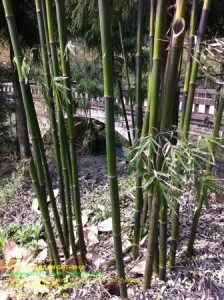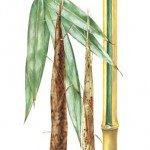 As part of our studies while we are here in China, we are collecting samples of bamboo at the CCRCGP Panda Base and analyzing for total mercury concentrations. Analyzing for mercury turns out to be the easy part. It’s identifying the bamboo species which can take a lot of time. Bamboo belongs to the family Poaceae or grass family. Worldwide there are 11,000 species of bamboo with 1,795 in China. To identify down to the individual species takes skill and a vast knowledge of plant systematics and morphological features, of which I also have very little. This is where a professional comes into play.
As part of our studies while we are here in China, we are collecting samples of bamboo at the CCRCGP Panda Base and analyzing for total mercury concentrations. Analyzing for mercury turns out to be the easy part. It’s identifying the bamboo species which can take a lot of time. Bamboo belongs to the family Poaceae or grass family. Worldwide there are 11,000 species of bamboo with 1,795 in China. To identify down to the individual species takes skill and a vast knowledge of plant systematics and morphological features, of which I also have very little. This is where a professional comes into play.
Without the internet we might not have access to most of our professional connections and the indispensable Flora of China (www.eflores.com). The Flora of China is a plant key to all the plants of China, and it also happens to be published online in english. This allows us to key out to what we think we are looking at, but then gives us the start to a dialogue with an actual botanist. Last year we were able to identify a common bamboo that grows on the side of the road here in Ya’an by collecting samples and pictures, then sending both to multiple bamboo specialists. Once we got everyone to agree on a species…presto!
 So in follow up to Julia’s original post, Botany is Hard!, we completely understand. As it turns out, when feeding the giant pandas, multiple species of bamboo can get collected without knowing one had even done so. The amount of mercury that the bamboo contains, as we previously found in Total Mercury in Wild Bamboo, is highest near city centers. So, the type of bamboo won’t have as big of an impact as does collection location. We will be collecting multiple species from multiple locations to further test our findings. As always, stay tuned for more updates and feel free to leave comments or questions.
So in follow up to Julia’s original post, Botany is Hard!, we completely understand. As it turns out, when feeding the giant pandas, multiple species of bamboo can get collected without knowing one had even done so. The amount of mercury that the bamboo contains, as we previously found in Total Mercury in Wild Bamboo, is highest near city centers. So, the type of bamboo won’t have as big of an impact as does collection location. We will be collecting multiple species from multiple locations to further test our findings. As always, stay tuned for more updates and feel free to leave comments or questions.

It’s amazing how many species of bamboo there are!
I think identifying all the plants in my study is equal to another dissertation project in terms of the amount of work.
I was a botany geek before being a toxicology geek and I still have a huge problem identifying these guys. Wish we could come see your field site, but it looks to be kinda expensive. I’m jealous that you get to climb in trees.